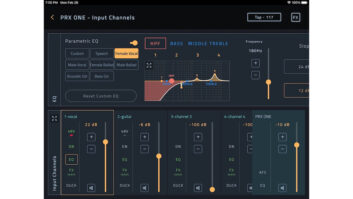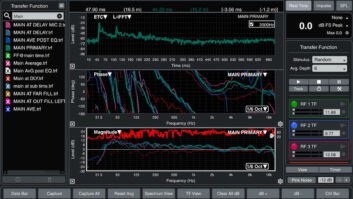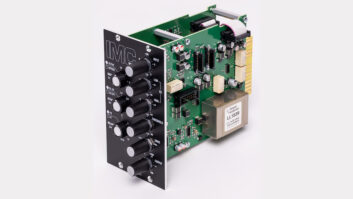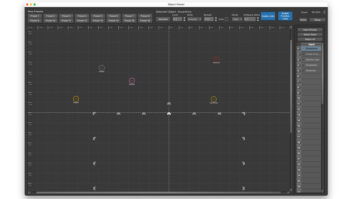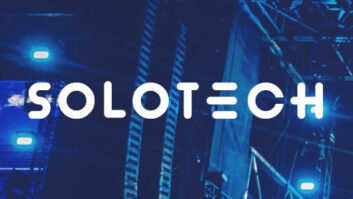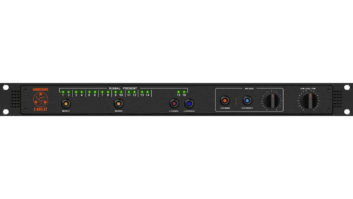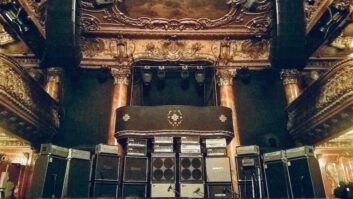Multi-instrumentalist on drums, bass & guitar, flies high playing live and engineering in the studio with Dangerous Music Gear
Edmeston, NY – June 25, 2013 – The journey from being a musician to becoming a mastering engineer began with Nate Wood making his own album and preferring the approach of recording and mixing the music himself, compared to going to a studio and trying to get someone else to make his music sound the way he was hearing it. After mixing his own album and projects for friends he found a new companion career to his live performances in mastering other people’s projects. Based in New York, Wood has outfitted his studio with the Dangerous Music D-Box for monitor control, reference D/A conversion, and analog summing for his mix path, along with the Dangerous Liaison programmable analog router with parallel processing for his six key pieces of outboard gear, two compressors and four EQs. The Liaison proved to be an elegant solution to his tedious practice of hand re-patching outboard gear for mastering sessions.
The D-Box is the cornerstone of Wood’s mastering studio, “I’m using every single function of the D-Box, every single day,” states Wood. “I use it as a monitor controller, I use the talkback, the two headphone outs, and the summing mixer. Basically every button gets pressed every day! The D-to-A in the D-Box is my main D-to-A for listening.”
“I use the headphones on the D-Box all the time for mastering, for fades and cleaning up edits. The D-Box headphone amp is a huge improvement over what I was using before, way more power and way more clarity. It drives higher impedance headphones better. It’s great to have two different outputs, one for me, and one for a client. The client wants to listen on headphones that he knows, and I want to listen on my headphones.”
Wood also utilizes the Dangerous Liaison for routing his analog outboard gear and for parallel compression in his mastering studio. “I have six pieces of outboard gear, and before I had the Liaison, I was crawling in back of the rack and hard-patching them, because I had worked with a patchbay before and I didn’t like the way it affected the sound. Now with the Liaison I can finally just patch them all in and my outboard sounds absolutely no different. I can switch between any chain of outboard gear in any way. I can put any piece in any order, so I’ve really been taking advantage of that. I have four EQs and two compressors that I go between. With 6 stereo inputs the Liaison is perfect for me.”
What’s on the Buss
“I’ve also experimented with the parallel buss on the Liaison, which is great,” says Wood. “If say I’m using the ‘Oz’ Handcrafted Labs Pultec-style EQ, but I want a little bit of ‘air’ after it, I can blend in another passive EQ that has a lot of obvious tonal coloration, without completely putting it in series in the circuit. It brings in just a hint of it, up under the main mix, all with no detrimental effects. I don’t notice any phasing or anything – it is a purely additive, beneficial property. It’s pretty cool!”
The beauty of the Liaison to Wood is that he can easily choose the order of any of his outboard gear and that he cannot hear the Liaison, “It just doesn’t add any color to the sound. Also having a client here and saying ‘Which one do you like? Do you like this compressor or this compressor?’ just by hitting one button. It’s not ‘Wait while I re-patch’ and have to climb behind the rack. It’s: ‘What does this sound like? What does this sound like? Then: ‘I like that one.’ If you are re-patching by hand, the client has forgotten what the other chain or compressor sounded like, so it’s much harder to preview options for the client,” explains Wood.
Getting Back to Dangerous Summing
Remembering earlier days when he mixed a lot more music, Wood explains the evolution of his preference for analog summing. Wood’s father, Steve Wood, is an accomplished professional musician who chose to leave touring many years ago to pursue producing, arranging, composing and mixing. But Nate has yet to follow in his father’s musical footsteps, he continues to play live, and when he’s not on tour focuses on mastering when he’s back in New York. “The reason that I got into audio was trying to make my own music sound as good as possible without having to go into someone else’s studio. Literally the first time I got the Dangerous 2-Bus LT summing mixer, I realized: ‘Ok, my sh*t sounds good now’ – I felt like I could actually do this for real.” That made all the difference. “I heard a sound that was different than other engineers, so I wanted to do it myself,” states Wood.
“I am not taking on clients as a mixing engineer anymore, but I am mixing my own projects, and ones for very close friends using the D-Box summing. I used to mix more and I used the Dangerous 2-Bus LT for all my mixes. The 2-Bus made such a huge difference at the time: it really made my mixes. When I got more into mastering I had to make room for more mastering gear and I started mixing my own projects in the box thinking it sounded OK. But there was something about my older mixes that I kind of missed in the newer stuff that I did in the box. I started thinking maybe it was the summing. I was mastering all of my friend Billy Mohler‘s projects and his mixes were sounding good. Then he sent me the first record that he mixed with the D-Box summing and I was like: ‘Whoa dude, this sounds like a real mix now!’ It sounded really different, and not like ‘Oh, you got better plug-ins’ – it feels different.”
“I knew Billy got a D-Box and loved it and was using the summing,” recalls Wood, “So I started brainstorming and thought I should get back into summing. At the same time I wanted a better monitor D-to-A, because I was using the one from my Lynx Aurora to monitor for mastering – the D-Box has all that stuff. That’s why I got the D-Box. Now I use the 8-channels out of the Aurora to the D-Box for summing. I did a record mixing in-the-box, a project I was working on with my band “weyou” and once I got the D-Box I remixed it through the D-Box summing and it turned out way better.”
When looking for a new D-to-A for monitoring Wood was on a mission, “I’ve had a lot of DACs in my studio to try them, the Crane Song Hedd, the Lavry DA10, the Mitek 96 – I feel like the D-Box is easily on the level of any of those. When I switched from the Aurora to the D-Box it was like ‘Oh Wow!’ Everything just got a lot cleaner and much easier to hear: way, way better. The Aurora is great for the summing/mix path, but for reference monitoring I feel like the D-Box ‘tells me things’ much quicker.”
The D-Box also suffices for Wood’s speaker switching, “I use three sets of speakers, I use an external line-level selector for 2 pairs of the speakers,” he explains. “I have Tyler Acoustic MM5 3-way, they go 28Hz to 20kHz, those are for mastering, and I have Proac Studio 100s and Avantones, the little Auratone copies.”
Transparency Matters
On the D-Box and the Liaison’s transparency, Wood reveals, “In the places in the signal path you don’t want to hear color, you really don’t want to hear it. You buy specific pieces of gear that will add tonal coloration or not, and that’s a very deliberate choice. Obviously for summing, for patching, and for monitor control you want it to be as transparent as possible. The monitor control section of the D-Box sounds way better than what I was using before too, which was a huge surprise to me. It was really surprising because I was using a really high-quality passive switcher before, with really short cable runs, and good cables and everything. The D-Box just immediately sounded way better to me. It was way easier to address problems in the mix or master. I was wary of active monitor controllers before this but not any more. The D-Box was substantially better.”
Balancing Act: Playing Live and Mastering
Like his father, Nate loves playing music, “Billy Mohler and I were in a rock band, ‘The Calling,’ we did a couple years of that together touring the world,” explains Wood. “I moved to New York about three years ago to get a little bit more into playing jazz with my friends. I am pretty active in the scene now. I play drums in a band called ‘Kneebody,’ it’s my main project, it’s a modern electric jazz band – young folks like us! We tour a lot and we’re Grammy-Nominated. I have toured with guitarist Wayne Krantz (Steely Dan) playing bass and drums, and I also play drums with an Armenian pianist, Tigran Hamasyan, who’s really exceptional. I did a tour where Keith Carlock (Steely Dan) played drums and I set up a second kit and we both played drums sometimes, and I’d play bass the rest of the time. I toured with Taylor Hawkins, the drummer from the Foo Fighters, I did two tours with his band playing rhythm guitar and singing backgrounds.” But between all the touring, there’s still plenty of time for Wood to be in his studio mixing his own music and mastering commercial projects for clients with his Dangerous Music gear.
Find out more about Nate Wood Mastering at: http://www.kerseboommastering.com
Visit some of Nate Woods’ other projects too:
The band Kneebody: http://kneebody.com
And music websites:
http://natewoodmusic.net
http://www.weyoumusic.com
http://natewood.bandcamp.com
About Dangerous Music
Dangerous Music, Inc. designs and builds products that are indispensable to any DAW-based recording environment. Dangerous Music electronics designer Chris Muth has spent over 20 years working in and designing custom equipment for top recording and mastering studios. Muth and company founder Bob Muller pioneered the concept of the dedicated analog summing buss for digital audio workstations with the Dangerous 2-Bus in 2001. Today the company offers a wide range of products for recording, mastering, mixing and post-production facilities, all designed and built with mastering-quality standards and a practical aesthetic. Key products include the Dangerous 2-Bus and 2-Bus LT, Dangerous Monitor ST-SR and its Additional Switching System expansion units, Dangerous D-Box, Dangerous Master, Dangerous Liaison, Dangerous Monitor, Dangerous Source and Dangerous Bax EQ.
For more information on Dangerous Music visit http://www.dangerousmusic.com phone 607-965-8011 or email: [email protected]
All trademarks are the property of their respective holders. Description and specifications are subject to change without notice.
